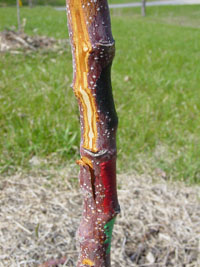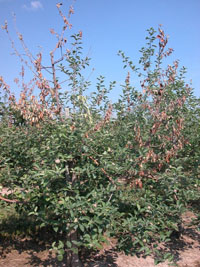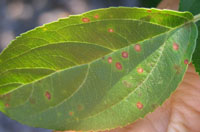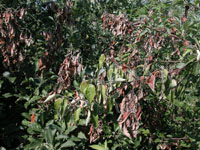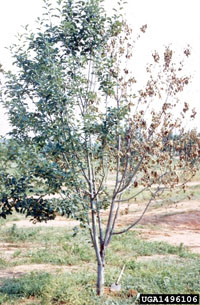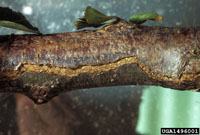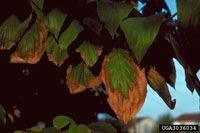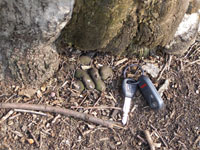Extension > Garden > Diagnose a problem > What's wrong with my plant? > Deciduous Trees > Crab Apple > Branch dieback
Crab Apple > Branch > Branch dieback
1 of 8
Winter Injury
- Injured branches leaf out and then die, or don’t leaf out at all
- Injured shoots and branches die quickly after warm weather arrives
- Common after very cold winters with little snow cover
- Dark streaking can be seen in the sapwood of injured branches
- More information on Winter Injury
2 of 8
Black Rot
Botryosphaeria obtusa
- Leaves on girdled branches wilt, die and turn brown
- Branch cankers can be sunken, reddish brown or rough looking or cracked bark; cankers may remain small or enlarge to become several feet long
- Round leaf spots with a purple border and tan center
- Large brown spots with brown rings form on fruit
- Fruit is rotted but remains firm
- Fruit may become mummified and remain on tree
- Common on stressed trees and trees infected with fire blight
- More information on Black Rot
3 of 8
Fire Blight
Erwinia amylovora
- Infected leaves wilt, turn gray then dark brown
- Young shoots bend over forming a "shepherd's crook"
- Infected blossoms first turn gray, then black
- Infected leaves and blossoms remain attached to the tree, often even in winter
- Branch cankers have dark, sunken and cracked bark, sapwood is streaked reddish brown
- Infected fruit are shriveled and discolored
- Drops of sticky honey colored liquid can be seen on infected plant parts in warm wet weather
- More information on Fire Blight
4 of 8
White Rot
Botryosphaeria dothidea
- Leaves on girdled branches wilt, die and turn brown
- Small blister like spots on branches exude, watery fluid
- Branch infections grow to cracked, flakey, orange canker
- Sunken brown spots on fruit, can grow to rot part or all of fruit
- Fruit rot is soft, watery and extends to the core of the apple
- More information on White Rot
5 of 8
Drought Stress
- Severe drought stress may cause dieback of individual branches
- Uniform wilting or browning of leaves throughout the tree
- Leaf margins and branch extremities usually brown and wilt first
- More information on Drought Stress
6 of 8
Dogwood Borer
Synanthedon scitula
- Larvae feed in young trees often around lawn mower injuries, and in pruning scars of older trees
- Feeding causes girdling and reduced sap flow
- Brownish-red frass (excrement) is usually present at the feeding site
- Adult is a black and yellow clear-wing moth, larvae are ½" long when mature, and white with a red-brown head
- Adult emergence begins in mid-June, peaks in early July, and continues until August
7 of 8
Oystershell Scale
Lepidosaphes ulmi
- Branch dieback can occur in severe infestations
- Fruit develop waxy, grayish brown, resembling miniature oyster shells
- More information on Oystershell Scale
8 of 8
Black Root Rot
Xylaria mali and Xylaria polymorpha
- Infected trees have slow growth, a thin canopy, dead branches, and small leaves
- Black finger-like projections arise from the soil at the base of the tree
- Infected roots are brittle and encrusted in black fungal growth
- Infected trees produce many very small fruit



